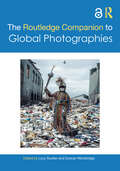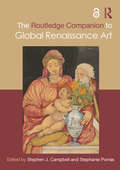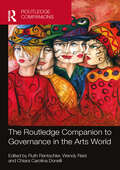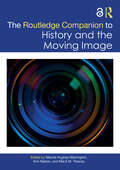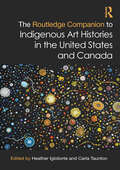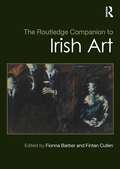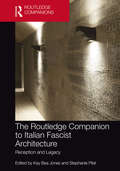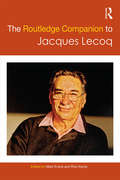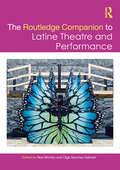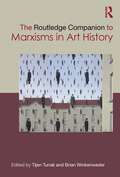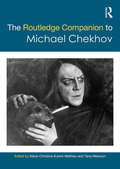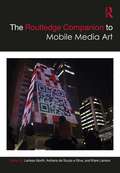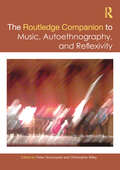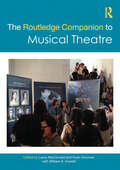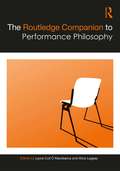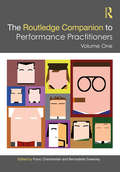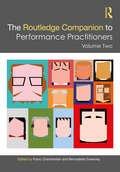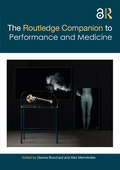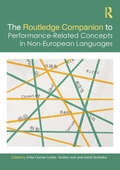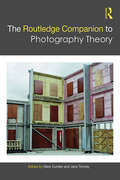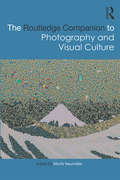- Table View
- List View
The Routledge Companion to Global Photographies (Routledge Art History and Visual Studies Companions)
by Lucy Soutter and Duncan WooldridgeIn response to widespread demand for more knowledge and insight about contemporary photographies beyond Western centers of production and dissemination, this volume provides a transnational discussion, grounded in dialogue between authors and editors from diverse locations and contexts.Ecological and decolonial discourses around photography reveal the medium’s global entanglements: images produced on one side of the globe are the result of labors which span its full surface. At the same time, the multiplicity of approaches and understandings of the photograph reveal that, even though it might seem like a universal language, we utilize its tools to radically different ends. The volume explores issues surrounding cultural translation, photography’s response to climate change, decolonial practices, network formation, new materialities, identities and the role of photobooks. It also provides in-depth surveys and case studies of global practices and theories, alongside interviews and roundtable discussions with key figures whose perspectives illuminate the contemporary field. This groundbreaking collection is an essential resource for academics and students working in or with photography, contextual studies, history, and theory, but also media and cultural studies more broadly.The Open Access version of this book, available at http://www.taylorfrancis.com, has been made available under a Creative Commons Attribution-Non Commercial-No Derivatives (CC-BY-NC-ND) 4.0 license.
The Routledge Companion to Global Renaissance Art (Routledge Art History and Visual Studies Companions)
by Stephen J. Campbell Stephanie PorrasThis companion examines the global Renaissance through object-based case studies of artistic production from Africa, Asia, the Americas, and Europe in the early modern period.The international group of contributors take an art historical approach characterized by close analysis of form and meaning as well as function, and a focus on questions of crosscultural dialogue and adaptation. Seeking to de-emphasize the traditional focus on Europe, this book is a critical guide to the literature and the state of the field. Chapters outline new questions and agendas while pushing beyond familiar material. Main themes include workshops, the migrations of artists, objects, technologies, diplomatic gifts, imperial ideologies, ethnicity and indigeneity, sacred spaces and image cults, as well as engaging with the open questions of "the Renaissance" and "the global."This will be a useful and important resource for researchers and students alike and will be of interest to scholars working in art history, visual culture, material culture, and Renaissance studies.The Open Access version of this book, available at www.taylorfrancis.com, has been made available under a Creative Commons [Attribution-Non Commercial-No Derivatives (CC-BY-NC-ND)] 4.0 license
The Routledge Companion to Governance in the Arts World (Routledge Companions in Business, Management and Marketing)
by Ruth RentschlerThis research compendium of arts governance brings expert insights from management through the humanities and social sciences to provide a comprehensive global overview of how the field is evolving as the world is in turmoil.Moving beyond the traditional governance focus on boards, the book is structured across a framework that provides five levels of analysis: individual board directors, boards, arts organisations, community collaborations and public policy instances around the world. Contributors examine urgent contemporary issues in arts governance such as toxic leadership, bad behaviour, discrimination and post-colonialism. They present governance definitional challenges, governance struggles for organisations of different sizes and types, in different regimes, with different accountabilities, complexities, collaborations and policy environments.Experts from around the world are brought together in this book to explore and illuminate the creative sector’s distinct dynamics in arts governance. The book is an essential scholarly resource for academics, students and reflective practitioners of arts and cultural management.
The Routledge Companion to History and the Moving Image (Routledge Companions)
by Marnie Hughes-Warrington Kim Nelson Treacey, Mia E.M.The Routledge Companion to History and the Moving Image takes an interdisciplinary approach to understanding history in moving images. It engages this popular and dynamic field that has evolved rapidly from film and television to digital streaming into the age of user-created content. The volume addresses moving image history through a theoretical lens; modes and genres; representation, race, and identity; and evolving forms and formats. It brings together a range of scholars from across the globe who specialize in film and media studies, cultural studies, history, philosophy of history, and education. Together, the chapters provide a necessary contemporary analysis that covers new developments and questions that arise from the shift to digital screen culture. The book examines technological and ethical concerns stemming from today’s media landscape, but it also considers the artificial construction of the boundaries between professional expertise and amateur production. Each contributor’s unique approach highlights the necessity of engaging with moving images for the academic discipline of history. The collection, written for a global audience, offers accessible discussions of historiography and a compelling resource for advanced undergraduates and postgraduates in history, film and media studies, and communications.
The Routledge Companion to History and the Moving Image (Routledge Companions)
by Marnie Hughes-Warrington Kim Nelson Treacey, Mia E.M.The Routledge Companion to History and the Moving Image takes an interdisciplinary approach to understanding history in moving images. It engages this popular and dynamic field that has evolved rapidly from film and television to digital streaming into the age of user-created content.The volume addresses moving image history through a theoretical lens; modes and genres; representation, race, and identity; and evolving forms and formats. It brings together a range of scholars from across the globe who specialize in film and media studies, cultural studies, history, philosophy of history, and education. Together, the chapters provide a necessary contemporary analysis that covers new developments and questions that arise from the shift to digital screen culture. The book examines technological and ethical concerns stemming from today’s media landscape, but it also considers the artificial construction of the boundaries between professional expertise and amateur production. Each contributor’s unique approach highlights the necessity of engaging with moving images for the academic discipline of history.The collection, written for a global audience, offers accessible discussions of historiography and a compelling resource for advanced undergraduates and postgraduates in history, film and media studies, and communications.Both Chapter 17 and the Afterword of this book are freely available as downloadable Open Access PDFs at http://www.taylorfrancis.com under a Creative Commons [Attribution-Non Commercial-No Derivatives (CC-BY-NC-ND)] 4.0 license.
The Routledge Companion to Indigenous Art Histories in the United States and Canada (Routledge Art History and Visual Studies Companions)
by Heather Igloliorte Carla TauntonThis companion consists of chapters that focus on and bring forward critical theories and productive methodologies for Indigenous art history in North America. This book makes a major and original contribution to the fields of Indigenous visual arts, professional curatorial practice, graduate-level curriculum development, and academic research. The contributors expand, create, establish and define Indigenous theoretical and methodological approaches for the production, discussion, and writing of Indigenous art histories. Bringing together scholars, curators, and artists from across the intersecting fields of Indigenous art history, critical museology, cultural studies, and curatorial practice, the companion promotes the study and dissemination of Indigenous art and stimulates new conversations on such key areas as visual sovereignty and self-determination; resurgence and resilience; land-based, embodied, and nation-specific knowledges; epistemologies and ontologies; curatorial and museological methodologies; language; decolonization and Indigenization; and collaboration, consultation, and mentorship.
The Routledge Companion to Irish Art (Routledge Art History and Visual Studies Companions)
by Fionna Barber Cullen FintanThis companion contains new and innovative writing on Irish art and its history, from c. 1800 to the present day.This book critically engages with Irish art in a period linked to key events in Irish history, beginning with the Acts of Union between Britain and Ireland (1800–01)) and the significant social and cultural changes that resulted. The book also provides a precedent for a focus on the significance of art in relation to other subsequent key historical events such as the early twentieth‑century struggles for independence or the role of political conflict in Northern Ireland from the late 1960s onwards and its aftermath. Key themes covered include tradition and innovation; upheavals of history; place, location, and artistic formations; Irish art and the wider world; and embodiment and identity. The book expands the critical discourse around Irish art over this period, both within Ireland and beyond, and encourages the potential for future scholarship in fields and periods not covered.This book will be of interest to scholars and students working in art history, Irish studies, and colonial studies.
The Routledge Companion to Italian Fascist Architecture: Reception and Legacy
by Kay Bea Jones Stephanie PilatToday, nearly a century after the National Fascist Party came to power in Italy, questions about the built legacy of the regime provoke polemics among architects and scholars. Mussolini’s government constructed thousands of new buildings across the Italian Peninsula and islands and in colonial territories. From hospitals, post offices and stadia to housing, summer camps, Fascist Party Headquarters, ceremonial spaces, roads, railways and bridges, the physical traces of the regime have a presence in nearly every Italian town. The Routledge Companion to Italian Fascist Architecture investigates what has become of the architectural and urban projects of Italian fascism, how sites have been transformed or adapted and what constitutes the meaning of these buildings and cities today. The essays include a rich array of new arguments by both senior and early career scholars from Italy and beyond. They examine the reception of fascist architecture through studies of destruction and adaptation, debates over reuse, artistic interventions and even routine daily practices, which may slowly alter collective understandings of such places. Paolo Portoghesi sheds light on the subject from his internal perspective, while Harald Bodenschatz situates Italy among period totalitarian authorities and their symbols across Europe. Section editors frame, synthesize and moderate essays that explore fascism’s afterlife; how the physical legacy of the regime has been altered and preserved and what it means now. This critical history of interpretations of fascist-era architecture and urban projects broadens our understanding of the relationships among politics, identity, memory and place. This companion will be of interest to students and scholars in a range of fields, including Italian history, architectural history, cultural studies, visual sociology, political science and art history.
The Routledge Companion to Jacques Lecoq (Routledge Companions)
by Mark Evans Rick KempThe Routledge Companion to Jacques Lecoq presents a thorough overview and analysis of Jacques Lecoq's life, work and philosophy of theatre. Through an exemplary collection of specially commissioned chapters from leading writers, specialists and practitioners, it draws together writings and reflections on his pedagogy, his practice, and his influence on the wider theatrical environment. It is a comprehensive guide to the work and legacy of one of the major figures of Western theatre in the second half of the twentieth century. In a four-part structure over fifty chapters, the book examines: The historical, artistic and social context out of which Lecoq's work and pedagogy arose, and its relation to such figures as Jacques Copeau, Antonin Artaud, Jean-Louis Barrault, and Dario Fo. Core themes of Lecoq's International School of Theatre, such as movement, play, improvisation, masks, language, comedy, and tragedy, investigated by former teachers and graduates of the School. The significance and value of his pedagogical approaches in the context of contemporary theatre practices. The diaspora of performance practice from the School, from the perspective of many of the most prominent artists themselves. This is an important and authoritative guide for anyone interested in Lecoq's work.
The Routledge Companion to Landscape Studies (Routledge International Handbooks)
by Emma Waterton Ian Thompson Peter Howard Mick AthaThis new edition of The Routledge Companion to Landscape Studies contains an updated and expanded selection of original chapters which explore research directions in an array of disciplines sharing a concern for ‘landscape’, a term which has many uses and meanings. It features 33 revised and/or updated chapters and 14 entirely new chapters on topics such as the Anthropocene, Indigenous landscapes, challenging landscape Eurocentrisms, photography and green infrastructure planning. The volume is divided into four parts: Experiencing landscape; Landscape, heritage and culture; Landscape, society and justice; and Design and planning for landscape. Collectively, the book provides a critical review of the various fields related to the study of landscapes, including the future development of conceptual and theoretical approaches, as well as current empirical knowledge and understanding. It encourages dialogue across disciplinary barriers and between academics and practitioners, and reflects upon the implications of research findings for local, national and international policy in relation to landscape. The Companion provides a comprehensive and up-to-date guide to current thinking about landscapes, and serves as an invaluable point of reference for scholars, researchers and graduate students alike.
The Routledge Companion to Latine Theatre and Performance (Routledge Companions)
by Noe Montez Olga Sanchez SaltveitThe Routledge Companion to Latine Theatre and Performance traces how manifestations of Latine self-determination in contemporary US theatre and performance practices affirm the value of Latine life in a theatrical culture that has a legacy of misrepresentation and erasure.This collection draws on fifty interdisciplinary contributions written by some of the leading Latine theatre and performance scholars and practitioners in the United States to highlight evolving and recurring strategies of world making, activism, and resistance taken by Latine culture makers to gain political agency on and off the stage. The project reveals the continued growth of Latine theatre and performance through chapters covering but not limited to playwriting, casting practices, representation, training, wrestling with anti-Blackness and anti-Indigeneity, theatre for young audiences, community empowerment, and the market forces that govern the US theatre industry. This book enters conversations in performance studies, ethnic studies, American studies, and Latina/e/o/x studies by taking up performance scholar Diana Taylor’s call to consider the ways that “embodied and performed acts generate, record, and transmit knowledge.”This collection is an essential resource for students, scholars, and theatremakers seeking to explore, understand, and advance the huge range and significance of Latine performance.
The Routledge Companion to Marxisms in Art History (Routledge Art History and Visual Studies Companions)
by Tijen Tunalı Brian WinkenwederThis companion is an essential contribution to the study of historical materialism in general and the social history of art in particular.Each chapter in the collection focuses on a key figure, concept or historical epoch. Increasingly, scholars adopt an array of Marxist methods intertwined with a host of other theoretical practices, particularly the historiography of key issues regarding hegemony, ideology and identity. Ideological issues of connoisseurship, patronage and analyses of the artwork as a form of labor and leisure are essential to the practice of Marxisms in art history. This collection spotlights a plurality of Marxian theories in which the ideas of such figures as Walter Benjamin, Guy Debord and T.J. Clark are debated and developed through analyses of the socio-historical conditions that impact how art is produced, circulated and received. This ultimately underscores that the historical contextualization of artworks and their "markets" within a class-based society is crucial for writing socially engaged art history.This book will be of interest to scholars working in art history, visual studies, visual sociology, communication studies and the sociology of art.
The Routledge Companion to Michael Chekhov (Routledge Companions)
by Yana Meerzon Marie Christine Autant MathieuThe Routledge Companion to Michael Chekhov brings together Chekhov specialists from around the world - theatre practitioners, theorists, historians and archivists – to provide an astonishingly comprehensive assessment of his life, work and legacy. This volume aims to connect East and West; theatre theory and practice. It reconsiders the history of Chekhov’s acting method, directing and pedagogy, using the archival documents found across the globe: in Russia, England, America, Germany, Lithuania and Switzerland. It presents Chekhov’s legacy and ideas in the framework of interdisciplinary theatre practices and theories, as well as at the crossroads of cultures, in the context of his forays into such areas as Western mime and Asian cosmology. This remarkable Companion, thoughtfully edited by two leading Chekhov scholars, will prove invaluable to students and scholars of theatre, theatre practitioners and theoreticians, and specialists in Slavic and transcultural studies. Marie-Christine Autant-Mathieu is Director of Research at the National Center For Scientific Research, and Assistant-Director of Sorbonne-CNRS Institute EUR’ORBEM. She is an historian of theatre and specialist in Russian and Soviet theatre.Yana Meerzon is Associate Professor in the Department of Theatre, University of Ottawa. Her book publications include Adapting Chekhov: The Text and Its Mutations, co-edited with Professor J. Douglas Clayton, University of Ottawa (Routlegde, 2012).
The Routledge Companion to Mobile Media Art (Routledge Media and Cultural Studies Companions)
by Larissa HjorthIn this companion, a diverse, international and interdisciplinary group of contributors and editors examine the rapidly expanding, far-reaching field of mobile media as it intersects with art across a range of spaces—theoretical, practical and conceptual. As a vehicle for—and of—the everyday, mobile media is recalibrating the relationship between art and digital networked media, and reshaping how creative practices such as writing, photography, video art and filmmaking are being conceptualized and practised. In exploring these innovations, The Routledge Companion to Mobile Media Art pulls together comprehensive, culturally nuanced and interdisciplinary approaches; considerations of broader media ecologies and histories and political, social and cultural dynamics; and critical and considered perspectives on the intersections between mobile media and art. This book is the definitive publication for researchers, artists and students interested in comprehending all the various aspects of mobile media art, covering digital media and culture, internet studies, games studies, anthropology, sociology, geography, media and communication, cultural studies and design.
The Routledge Companion to Modernity, Space and Gender
by Alexandra StaubThe Routledge Companion to Modernity, Space and Gender reframes the discussion of modernity, space and gender by examining how "modernity" has been defined in various cultural contexts of the twentieth and twenty-first centuries, how this definition has been expressed spatially and architecturally, and what effect this has had on women in their everyday lives. In doing so, this volume presents theories and methods for understanding space and gender as they relate to the development of cities, urban space and individual building types (such as housing, work spaces or commercial spaces) in both the creation of and resistance to social transformations and modern global capitalism. The book contains a diverse range of case studies from the US, Europe, the UK, and Asian countries such as China and India, which bring together a multiplicity of approaches to a continuing and common issue and reinforces the need for alternatives to the existing theoretical canon.
The Routledge Companion to Music, Autoethnography, and Reflexivity (Routledge Music Companions)
by Christopher Wiley Peter GouzouasisThe Routledge Companion to Music, Autoethnography, and Reflexivity represents a substantial contribution to the field of writing self-reflexively about an individual’s practice within music studies. In seven sections, 22 original chapters by a diverse set of contributors consider writing about personal activities from the points of view of performance, composition, musicology, and pedagogy, drawing on a range of traditions from Western art-music to popular music to ethnomusicology. A robust critical framework is presented, with coverage of: historical and critical perspectives different methodologies and their ascendancy within the academy leading debates, issues, and approaches future directions The Companion cultivates new modes of engagement in music research, enabling scholars and practitioners at all levels to identify and articulate their relationship to the wider sociocultural contexts in which they operate.
The Routledge Companion to Musical Theatre (Routledge Companions)
by William A. Everett Laura MacDonald Ryan DonovanGlobal in scope and featuring thirty-five chapters from more than fifty dance, music, and theatre scholars and practitioners, The Routledge Companion to Musical Theatre introduces the fundamentals of musical theatre studies and highlights developing global trends in practice and scholarship. Investigating the who, what, when, where, why, and how of transnational musical theatre, The Routledge Companion to Musical Theatre is a comprehensive guide for those studying the components of musical theatre, its history, practitioners, audiences, and agendas. The Companion expands the study of musical theatre to include the ways we practice and experience musicals, their engagement with technology, and their navigation of international commercial marketplaces. The Companion is the first collection to include global musical theatre in each chapter, reflecting the musical’s status as the world’s most popular theatrical form. This book brings together practice and scholarship, featuring essays by leading and emerging scholars alongside luminaries such as Chinese musical theatre composer San Bao, Tony Award-winning star André De Shields, and Tony Award-winning director Diane Paulus. This is an essential resource for students on theatre and performance courses and an invaluable text for researchers and practitioners in these areas of study.
The Routledge Companion to Paradigms of Performativity in Design and Architecture: Using Time to Craft an Enduring, Resilient and Relevant Architecture
by Mitra KanaaniThe Routledge Companion to Paradigms of Performativity in Design and Architecture focuses on a non-linear, multilateral, ethical way of design thinking, positioning the design process as a journey. It expands on the multiple facets and paradigms of performative design thinking as an emerging trend in design methodology. This edited collection explores the meaning of performativity by examining its relevance in conjunction with three fundamental principles: firmness, commodity and delight. The scope and broader meaning of performativity, performative architecture and performance-based building design are discussed in terms of how they influence today’s design thinking. With contributions from 45 expert practitioners, educators and researchers, this volume engages theory, history, technology and the human aspects of performative design thinking and its implications for the future of design.
The Routledge Companion to Performance Philosophy (Routledge Companions)
by Laura Cull Ó MaoilearcaThe Routledge Companion to Performance Philosophy is a volume of especially commissioned critical essays, conversations, collaborative, creative and performative writing mapping the key contexts, debates, methods, discourses and practices in this developing field. Firstly, the collection offers new insights on the fundamental question of how thinking happens: where, when, how and by whom philosophy is performed. Secondly, it provides a plurality of new accounts of performance and performativity – as the production of ideas, bodies and knowledges – in the arts and beyond. Comprising texts written by international artists, philosophers and scholars from multiple disciplines, the essays engage with questions of how performance thinks and how thought is performed in a wide range of philosophies and performances, from the ancient to the contemporary. Concepts and practices from diverse geographical regions and cultural traditions are analysed to draw conclusions about how performance operates across art, philosophy and everyday life. The collection both contributes to and critiques the philosophy of music, dance, theatre and performance, exploring the idea of a philosophy from the arts. It is crucial reading material for those interested in the hierarchy of the relationship between philosophy and the arts, advancing debates on philosophical method, and the relation between Performance and Philosophy more broadly.
The Routledge Companion to Performance Practitioners: Volume One (Routledge Companions)
by Franc Chamberlain; Bernadette SweeneyThe Routledge Companion to Performance Practitioners collects the outstanding biographical and production overviews of key theatre practitioners first featured in the popular Routledge Performance Practitioners series of guidebooks. Each of the chapters is written by an expert on a particular figure, from Stanislavsky and Brecht to Laban and Decroux, and places their work in its social and historical context. Summaries and analyses of their key productions indicate how each practitioner's theoretical approaches to performance and the performer were manifested in practice. All 22 practitioners from the original series are represented, with this volume covering those born before the end of the First World War. This is the definitive first step for students, scholars and practitioners hoping to acquaint themselves with the leading names in performance, or deepen their knowledge of these seminal figures.
The Routledge Companion to Performance Practitioners: Volume Two (Routledge Companions)
by Franc Chamberlain; Bernadette SweeneyThe Routledge Companion to Performance Practitioners collects the outstanding biographical and production overviews of key theatre practitioners first featured in the popular Routledge Performance Practitioners series of guidebooks. Each of the chapters is written by an expert on a particular figure, from Stanislavsky and Brecht to Laban and Decroux, and places their work in its social and historical context. Summaries and analyses of their key productions indicate how each practitioner's theoretical approaches to performance and the performer were manifested in practice. All 22 practitioners from the original series are represented, with this volume covering those born after 1915. This is the definitive first step for students, scholars and practitioners hoping to acquaint themselves with the leading names in performance, or deepen their knowledge of these seminal figures.
The Routledge Companion to Performance and Medicine (Routledge Companions)
by Alex Mermikides Gianna BouchardThe Routledge Companion to Performance and Medicine addresses the proliferation of practices that bridge performance and medicine in the contemporary moment.The scope of this book's broad range of chapters includes medicine and illness as the subject of drama and plays; the performativity of illness and the medical encounter; the roles and choreographies of the clinic; the use of theatrical techniques, such as simulation and role-play, in medical training; and modes of performance engaged in public health campaigns, health education projects and health-related activism. The book encompasses some of these diverse practices and discourses that emerge at the interface between medicine and performance, with a particular emphasis on practices of performance.This collection is a vital reference resource for scholars of contemporary performance; medical humanities; and the variety of interdisciplinary fields and debates around performance, medicine, health and their overlapping collaborations.Chapter 18 of this book is freely available as a downloadable Open Access PDF at http://www.taylorfrancis.com under a Creative Commons Attribution CC-BY 4.0 license.
The Routledge Companion to Performance-Related Concepts in Non-European Languages (ISSN)
by Erika Fischer-Lichte Torsten Jost Astrid SchenkaInvestigating more than 70 key concepts relating to the performing arts in more than six non-European languages, this volume provides a groundbreaking research tool and one-of-a-kind reference source for theatre, performance and dance studies worldwide.The Companion features in-depth explorations of and expert introductions to a select number of performance-related key concepts in Arabic, Chinese, Japanese, Korean, Yorùbá as well as the Indian languages Sanskrit, Hindi and Tamil. Key concepts—such as Furǧa فرجة in Arabic, for example, or Jiadingxing 假定性 in Chinese, Gei 芸 in Japanese, Ìparadà in Yorùbá and Imyeon 이면 in Korean—that defy easy translation from one language to another (and especially into English as the world’s lingua franca) and that reflect culturally specific ways of thinking and talking about the performing arts are thoroughly examined in in-depth articles. Written by more than 60 distinguished scholars from around the globe, the articles describe in detail each concept’s dynamic history, its flexible scope of meaning and current range of usage. The Companion also includes extensive introductions to each language section, in which internationally renowned experts explain how the presented key concepts are situated within, and are constitutive of, distinct and dynamic epistemic systems that have different yet always interlinked histories and orientations. Offers a fascinating insight into the unique histories, characteristics, and orientations of linguistically and culturally distinct epistemic systems related to the performative arts Contains extensive cross-references and bibliographies An invaluable research tool and one-of-a-kind reference source for scholars and students worldwide and across the humanities, especially in the fields of theatre, performance, dance, translation, area and cultural studies An accessible handbook for everybody interested in performance cultures and performance-related knowledge systems existing in the world today. This volume provides an invaluable research tool and one-of-a-kind reference source for scholars and students worldwide and across the humanities, especially in the fields of theatre, performance, dance, translation and area studies, history (of science and the humanities) and cultural studies.
The Routledge Companion to Photography Theory (Routledge Art History and Visual Studies Companions)
by Jane Tormey Mark DurdenWith newly commissioned essays by some of the leading writers on photography today, this companion tackles some of the most pressing questions about photography theory’s direction, relevance, and purpose. This book shows how digital technologies and global dissemination have radically advanced the pluralism of photographic meaning and fundamentally transformed photography theory. Having assimilated the histories of semiotic analysis and post-structural theory, critiques of representation continue to move away from the notion of original and copy and towards materiality, process, and the interdisciplinary. The implications of what it means to ‘see’ an image is now understood to encompass, not only the optical, but the conceptual, ethical, and haptic experience of encountering an image. The 'fractal' is now used to theorize the new condition of photography as an algorithmic medium and leads us to reposition our relationship to photographs and lend nuances to what essentially underlies any photography theory — that is, the relationship of the image to the real world and how we conceive what that means. Diverse in its scope and themes, The Routledge Companion to Photography Theory is an indispensable collection of essays and interviews for students, researchers, and teachers. The volume also features extensive images, including beautiful colour plates of key photographs.
The Routledge Companion to Photography and Visual Culture (Routledge Art History and Visual Studies Companions)
by Moritz NeumüllerThe Routledge Companion to Photography and Visual Culture is a seminal reference source for the ever-changing field of photography. Comprising an impressive range of essays and interviews by experts and scholars from across the globe, this book examines the medium’s history, its central issues and emerging trends, and its much-discussed future. The collected essays and interviews explore the current debates surrounding the photograph as object, art, document, propaganda, truth, selling tool, and universal language; the perception of photography archives as burdens, rather than treasures; the continual technological development reshaping the field; photography as a tool of representation and control, and more. One of the most comprehensive volumes of its kind, this companion is essential reading for photographers and historians alike.
